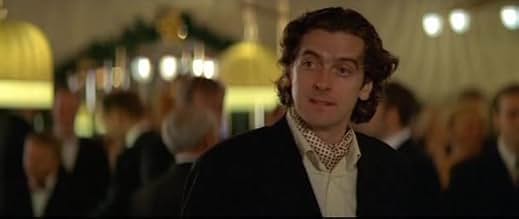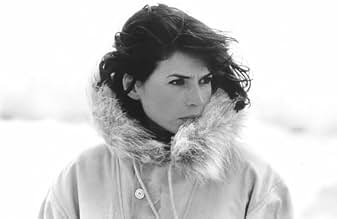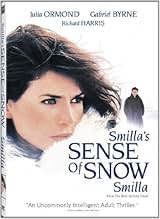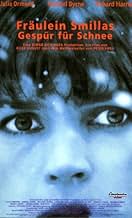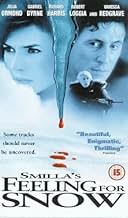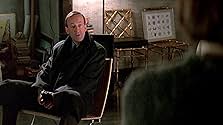Ein 6 Y.o. Inuit Junge läuft von einem verschneiten Dach in Kopenhagen und stirbt. Smilla, eine halbe Inuit, die in dem Gebäude wohnt und den Jungen kennt, schaut hinein. Was bringt einen ak... Alles lesenEin 6 Y.o. Inuit Junge läuft von einem verschneiten Dach in Kopenhagen und stirbt. Smilla, eine halbe Inuit, die in dem Gebäude wohnt und den Jungen kennt, schaut hinein. Was bringt einen akrophahoben Jungen auf das Dach? Die Hinweise führen sie nach Grönland.Ein 6 Y.o. Inuit Junge läuft von einem verschneiten Dach in Kopenhagen und stirbt. Smilla, eine halbe Inuit, die in dem Gebäude wohnt und den Jungen kennt, schaut hinein. Was bringt einen akrophahoben Jungen auf das Dach? Die Hinweise führen sie nach Grönland.
- Regie
- Drehbuch
- Hauptbesetzung
- Auszeichnungen
- 1 Nominierung insgesamt
- Inuit Hunter
- (as Ona Fletcher)
- Pastor
- (as Charles Lewson)
Empfohlene Bewertungen
The picture based on Peter Hoeg's best seller novel packs suspense,thrills,intrigue, tension and interesting character study. The story is well developed though its final fail to sustain the outcome and is a little bit crappy. Suspenseful and mysterious musical score by Hans Zimmer and Harry Gregson-Williams. Exceptional secondary casting mostly formed by British actors such as Jim Broadbent,Vanessa Redgrave,Bob Peck, Tom Wilkinson, among them. Evocative and cold cinematography is consistently created by Jorgen Persson, Billie August's usual cameraman.Location photography is particularly breathtaking with impressive images like a large icebreaker ship, snowy outdoors and giant floes thawing, among others. This partially successful first attempt at the thriller and tense mystery is efficiently directed by August. Billie is the Danish's best director, an expert on intelligent dramas as ¨Pelle the conqueror¨which took the best foreign-language film Oscar , ¨Twist and shout¨,¨The best intentions¨, ¨House of spirits¨, and ¨Les Miserables¨. Rating : Well worth seeing, better than average.
The makers succeeded well in capturing the complexity of the book's characters. Julia Ormond does remarkably well as the moody, unpredictable Smilla Jaspersen. So does Gabriel Byrne in the role of the rather secretive Mechanic. The brilliant Richard Harris is in here too, one of the many movies he probably said that it would be his last. The rest of the cast fits in well. Nice to see that they didn't try to get all big names, but rather actors who can fill a role appropriately.
Of course the movie isn't perfect, but in order to give that book full credit, they would have had to make a 4 hour film. Especially the second part, with all the events on the ship and in Greenland, is rather condensed. Those scenes could have used a bit more air to breathe, less pace.
Nevertheless I really like this movie, I have been watching it several times already. And now I think I am going to read the book again... (8/10)
The victim of a possible murder is a 6 year old boy whom you gradually get to know and care for deeply via flash backs of his tragic life.
One of the themes is trust. Smilla never knows whom she can trust. We in the audience weave back and forth trying to decide who is truly trying to help her and who to kill her or at least deflect her from her quest of finding out why and how someone would harm that little boy.
The movie is a maddening puzzle with clues coming thick and fast, but nothing making much sense. All you know is some very powerful people are involved and are ruthless in keeping silence. Smilla takes huge risks to gather information she has no particular reason to believe may be relevant other than others seem to be hiding it. Like a standard mystery novel, all is finally explained.
One interesting twist is, you in the audience even begin to distrust the caustic Smilla with her one-pointed push for vengeance.
Usually in a movie with a great many characters, I often find it hard to keep from confusing them. In this movie, the characters are all distinctly drawn, partly with a rich mixture of accents, so I had no such problem.
Some of the casting choices seemed a bit off, in particular Smilla's father's new teenage wife, Benja, who was obviously much older than a teenager, which made some of Smilla's cracks about her age not ring true.
Isaiah and his mother belonged to Denmark's Greenlandic minority, and Smilla herself grew up in Greenland, the daughter of a Danish father and Greenlandic mother. She is in her late thirties, and works as a freelance mathematician and expert on the physics of ice and snow, although she has no formal academic qualifications. She discovers, however, that Isaiah's father was an employee of a Danish mining corporation and that he died in mysterious circumstances during an expedition to Greenland organised by this corporation. She begins to suspect that Isaiah's death was also in some way linked to the company, and learns that they are organising another voyage to Gela Alta, a small island off the coast of Greenland, although she does not know what the object of this voyage is. Nevertheless, she believes that the key to the mystery lies on this remote island and joins the crew of the ship as a stewardess, just ahead of the police who resent her interference in the case and are trying to arrest her.
This was one of those films that I enjoyed more than the original novel. Peter Hoeg's book was itself in some ways reminiscent of a film. The first half, with its urban setting, its tough, gritty investigator and its suggestion of a web of corruption and wrongdoing in high places, reminded me of a Humphrey Bogart style film noir, and the second part, set on the ship as it makes its way through the Arctic ice, of one of those filmed versions of Alistair MacLean thrillers that were so popular in the sixties and seventies. I found, however, that it suffered from an over-complex plot and was too slow moving to work as a thriller. Bille August's version removes some of the complexity of the plot and moves along at a faster pace. The revelation about exactly what lies below the ice comes earlier in the film than it does in the book- possibly August realized that the book's ending, more science fiction than science fact, was one of its weak points, and wanted to get this detail out of the way to allow the closing scenes of the film to concentrate more on the battle between Smilla and the villains. The film keeps, however, the book's atmospheric sense of place- there were some wonderful shots of Copenhagen in winter and of the Arctic ice.
Julia Ormond seemed to be the cinema's Big New Thing of the mid-nineties. Her role in 'Smilla's Sense of Snow' followed starring roles in three big Hollywood films, 'Legends of the Fall', 'First Knight' and 'Sabrina'. Since then she seems to have disappeared from the radar altogether and I have often wondered what has happened to her.. Her performance in 'Smilla', however, is a good one and she makes an appealing heroine. Rather more appealing, in fact, than Hoeg's original character, who combines a strong sense of justice with a gift for rudeness and sarcasm. Of the other actors, the best was Richard Harris as the chief villain, although he was probably considerably older than the character envisaged by Hoeg.
Although it is very different in its visual style, this atmospheric thriller is perhaps the nearest that the modern cinema comes to old-fashioned film noir. Despite its weaknesses it remained watchable throughout. It confirmed my view (based on 'Pelle the Conqueror' and 'The House of the Spirits') that Bille August is a highly talented director. 7/10
Wusstest du schon
- WissenswertesDuring filming on location in Greenland Richard Harris got into the freezing water of the Arctic for a scene where he has to try and climb out of the water onto an ice floe. Afterwards he said it was madness that he had agreed to do it.
- PatzerWhen Smilla's father shows her the X-rays of the worms in the heart, he points out what remains of the liver and lower esophagus, then says "This is the heart, what's left of it". He's actually pointing to an upside-down X-ray of the upper abdomen. The "heart" is actually bowel gas in the intestine.
- Zitate
Smilla: The number system is like human life. First you have the natural numbers. The ones that are whole and positive. Like the numbers of a small child. But human consciousness expands. The child discovers longing. Do you know the mathematical expression for longing? The negative numbers. The formalization of the feeling that you're missing something.
- SoundtracksQuis est homo
from "Stabat Mater"
Written by Giovanni Battista Pergolesi
Performed by Kammerorchester 'Carl Philipp Emanuel Bach'
Conducted by Hartmut Haenchen
Top-Auswahl
- How long is Smilla's Sense of Snow?Powered by Alexa
Details
- Erscheinungsdatum
- Herkunftsländer
- Sprachen
- Auch bekannt als
- Smilla's Sense of Snow
- Drehorte
- Produktionsfirmen
- Weitere beteiligte Unternehmen bei IMDbPro anzeigen
Box Office
- Budget
- 35.000.000 $ (geschätzt)
- Bruttoertrag in den USA und Kanada
- 2.372.903 $
- Eröffnungswochenende in den USA und in Kanada
- 107.108 $
- 2. März 1997
- Weltweiter Bruttoertrag
- 2.372.903 $
- Laufzeit2 Stunden 1 Minute
- Farbe
- Sound-Mix
- Seitenverhältnis
- 2.35 : 1
Zu dieser Seite beitragen



